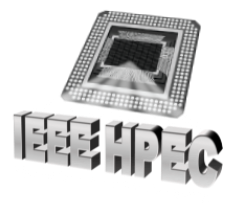

© Lorem Ipsum Dolor 2010
2013 IEEE High Performance
Extreme Computing Conference
(HPEC ‘13)
Seventeenth Annual HPEC Conference
10 - 12 September 2013
Westin Hotel, Waltham, MA USA













Site created and maintained by Ballos Associates
Open-System, Adiabatic Quantum nnealing
Dr. Robert Lucas, Director Computational Sciences USC ISI
With the end of Dennard scaling, and soon Moore's Law as well, those seeking ever increasing computational capability need to start considering
alternatives to large-scale clusters of commercial microprocessors. Towards that end, the University of Southern California - Lockheed Martin
Quantum Computing Center has taken delivery of two generations of D-Wave open-system, adiabatic quantum annealers. In this talk, we will report
on our experience assessing the quantum mechanical behavior of the devices and benchmarking their performance. We will present experimental
results that strongly indicate that quantum annealing is indeed being performed by D-Wave One, and show how the device performs when compared
to classical computers on a particular optimization problem. We will also discuss ongoing work to find applications where such a device can uniquely
augment our ability to solve them.
Software-Defined IDS for Securing Embedded Mobile Devices
Richard Skowyra, Boston University; Sanaz Bahargam, Boston University; Azer Bestavros, Boston University
Abstract: The increasing deployment of networked mobile embedded devices leads to unique challenges communications security. This is
especially true for embedded biomedical devices and robotic materials handling, in which subversion or denial of service could result in loss of
human life and other catastrophic outcomes. In this paper we present the Learning Intrusion Detection System (L-IDS), a network security service
for protecting embedded mobile devices within institutional boundaries, which can be deployed alongside existing security systems with no
modifications to the embedded devices. L-IDS utilizes the OpenFlow Software-Defined Networking architecture, which allows it to both detect and
respond to attacks as they happen.
Integrity Verification for Path Oblivious-RAM
Ling Ren, MIT; Christopher Fletcher, MIT; Xiangyao Yu, MIT; Marten van Dijk, MIT; Srinivas Devadas, MIT
Abstract: Oblivious-RAMs (ORAM) are used to hide memory access patterns. Path ORAM has gained popularity due to its efficiency and simplicity.
In this paper, we propose an efficient integrity verification layer for Path ORAM, which only imposes 17% latency overhead. We also show that
integrity verification is vital to maintaining privacy for recursive Path ORAMs under active adversaries.









